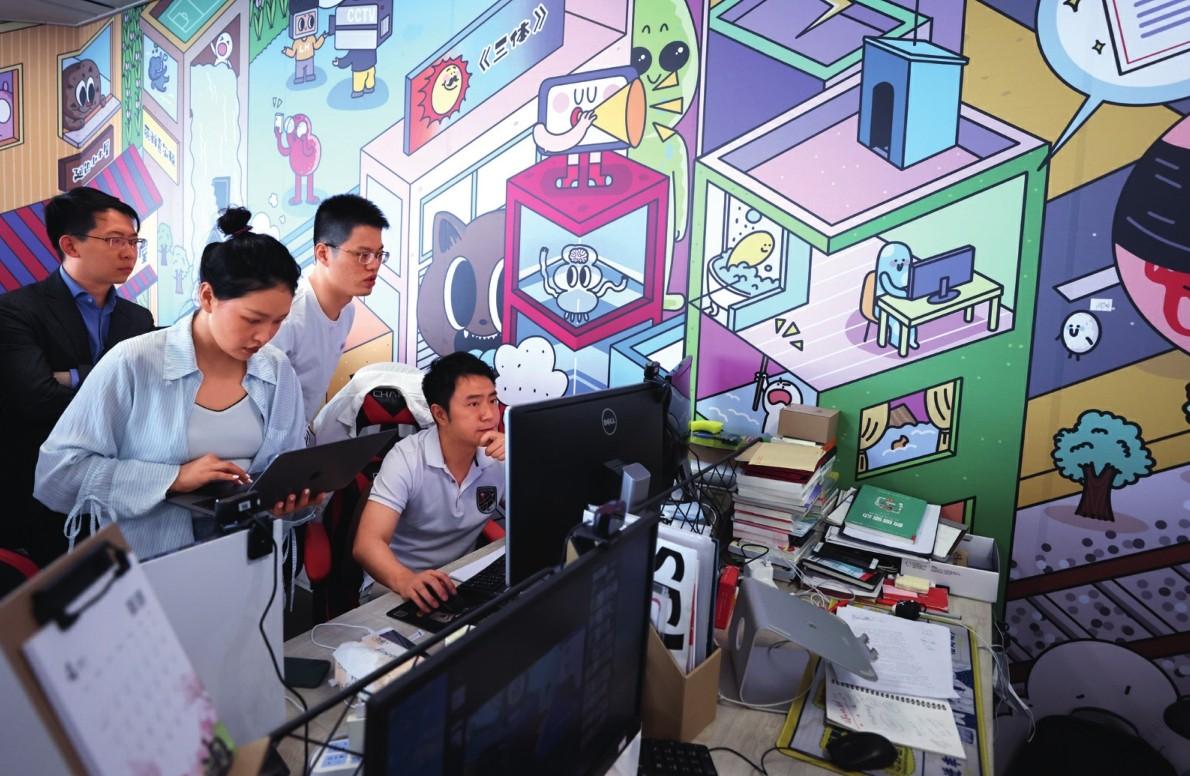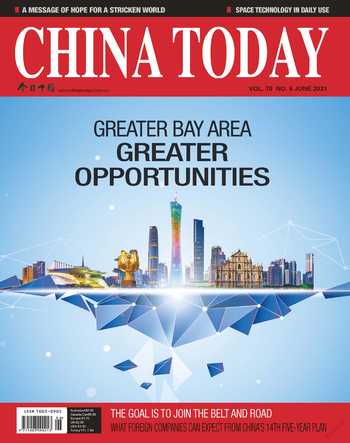Greater Bay Area:Elevating Reform and Opening-up
By TAO YITAO
THE development of the Guangdong-Hong Kong-Macao Greater Bay Area was highlighted in China’s Outline of the 14th Five-Year Plan for National Economic and Social Development and the Long-Range Objectives Through the Year 2035, which was adopted by the country’s top legislature in March this year. This means the Greater Bay Area, an economically open region with a strong market vitality, will play an important role in China’s comprehensive reform and opening-up, economic restructuring, and growth in technology. High expectations are also placed on the area in terms of maintaining long-term stability and prosperity in Hong Kong and Macao, and exploring and implementing new mechanisms for coordinated regional development.
Spearheaded by Technology
According to the 14th Five-Year Plan, support will be given to Beijing, Shanghai, and the Greater Bay Area in emerging as international hubs for technological innovation. This means, after more than four decades of reform and opening-up in China, the Greater Bay Area will move from a manufacturing powerhouse to a hive of technological innovations.
The building of the Greater Bay Area represents China’s new move to drive opening-up on all fronts, as well as a new practice in advancing the “one country, two systems” policy. Like the initiation of the special economic zone (SEZ) more than 40 years ago, it is a milestone in China’s reform and opening-up. It is not only a result of the reform and opening-up, but also an essential path to common prosperity in the mainland, Hong Kong, and Macao.
Integrated Development
Making use of its geographical advantages, the Greater Bay Area will contribute to the long-term stability and prosperity of Hong Kong and Macao. It will help break down institutional barriers, and build up consensus and mutual trust between the mainland and Hong Kong and Macao.
According to the Doing Business 2020 Report released by the World Bank, Hong Kong ranked third out of 190 economies across the world in the ease of doing business, moving up one place from the previous year’s position. The Canadabased Fraser Institute ranked Hong Kong as the world’s freest economy in the Economic Freedom of the World: 2020 Annual Report. With a rating of 8.94 in 2020, Hong Kong had held the top rank for 24 consecutive years.
In the early days of the re-form and opening-up, Hong Kong boosted the mainland’s development. Today, the mainland is moving toward prosperity together with Hong Kong and Macao. In retrospect, Hong Kong played an extremely important role in the success of the Shenzhen Special Economic Zone and China’s reform and opening-up drive. For quite a long period of time, Hong Kong has served as a window for the mainland to understand the outside world, learn about the market economy, and integrate into the international community. Undoubtedly, exchanges in capital, goods, technologies, and talent with Hong Kong have pushed forward the reform and opening-up process in the mainland, particularly in Shenzhen.

Today, the growth and prosperity of the mainland is not only benefiting 7.3 million residents in Hong Kong, but also has enhanced the competitive edge of the special administrative region. The 2020 edition of the Global Innovation Index released by the World Intellectual Property Organization showed that Shenzhen-Hong Kong-Guangzhou was the second best-performing science and technology city cluster worldwide based on a ranking of their science and technology intensity, which is the sum of their patent and scientific publication shares divided by population. Next to Tokyo-Yokohama, the Chinese city cluster has overtaken the San Jose-San Francisco cluster where Silicon Valley is located.
With mutually recognized rules, the transaction cost will remain low, ensuring market efficiency. In advancing integrated development, the Greater Bay Area makes the alignment of rules and mechanisms a priority. A slew of explorative measures regarding market access, market regulation, and government services have been implemented. National treatment applies across the Greater Bay Area when it comes to the application and implementation of scientific research projects as well as related fund management and results evaluation and commercialization. A sharing market has been established to maximize the social benefits of innovative study, commercialization of scientific achievements, and patents creation and use. Human resources also move freely across the area, injecting infinite creativity to the Greater Bay Area.
Institutional Innovation
The Guangdong-Hong Kong-Macao Greater Bay Area covers the Hong Kong Special Administrative Region (SAR), the Macao SAR, and nine cities in Guangdong Province, which are Guangzhou, Shenzhen, Zhuhai, Foshan, Huizhou, Dongguan, Zhongshan, Jiangmen, and Zhaoqing.

Based on the principle of regional community of shared benefits, the three regions should further give play to the roles of their joint conference mechanism and various special task groups, and build a government-level coordination and dialogue mechanism. These arrangements will facilitate coordination in infrastructure construction, installation of technological equipment and facilities, and innovative cooperation in major industries. Only when cross-region coordination is ensured, will specific partnerships in foreign trade, financial services, and public services among other areas be planned in an integrated manner to make use of each place’s unique advantages.
In addition, the three regions should establish a public service platform through negotiations to facilitate the free flow of human resources and coordinate such issues as employment, residency, innovation, and entrepreneurial adventures across the area.
The free flow of human resources and other factors of production is the key for maintaining market vitality in the Greater Bay Area. A priority of the coordination mechanism is to set up various standards for such flow through consultations. There should be a unified service standard or management model for industries closely associated with residents’ employment and lives, thus improving the administrative efficiency. For example, joint agencies can be established for certifications of such professions as doctors, nurses, and accountants. The same method can be used in issuing product certifications and setting up standards for the service sector.
The supply of such public institution will boost the free flow of various factors of production. It will in turn deepen regional cooperation, and drive the development of neighboring regions. The success of the Greater Bay Area will not only provide quality factors of production, but also institutional experience other places can draw upon.
The Greater Bay Area will emerge as a growth pole powerful enough to spearhead a higher level of reform and opening-up across the nation. Like SEZs and free trade zones, it has a unique mission entrusted by the era in which we live. More than 40 years ago, China’s reform and opening-up started from the place where the planned economy system was the weakest. Today, comprehensive deepening of reform took off at the place where the socialist market economy is the most developed.

- CHINA TODAY的其它文章
- Living a Quality Life
- Xi Jinping Speaks with UN Secretary-General Antonio Guterres on the Phone
- More Steps Taken to Protect Language Resources
- Renewables Bolster China’s High-Quality Development
- International Garden Festival Kicks off in Beijing
- WHO Approval of Chinese Vaccines Can Increase Global Supply

